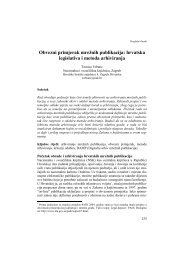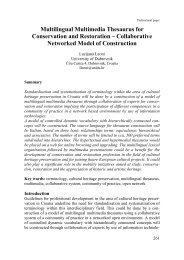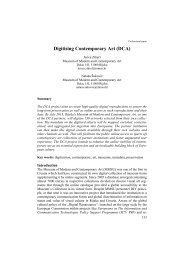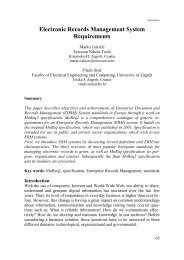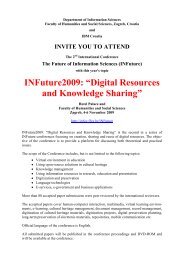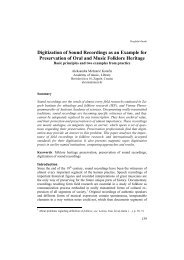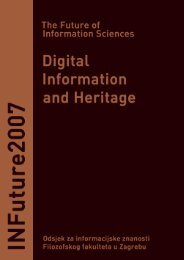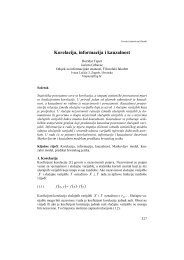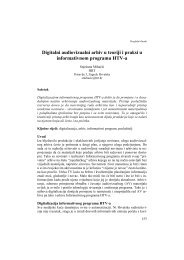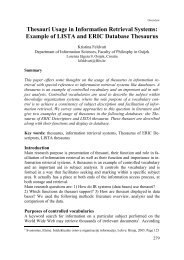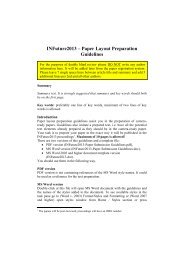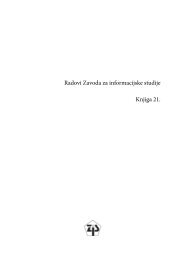Virtual Learning Spaces: Example of International Collaboration
Virtual Learning Spaces: Example of International Collaboration
Virtual Learning Spaces: Example of International Collaboration
Create successful ePaper yourself
Turn your PDF publications into a flip-book with our unique Google optimized e-Paper software.
Original scientific paper<br />
<strong>Virtual</strong> <strong>Learning</strong> <strong>Spaces</strong>: <strong>Example</strong> <strong>of</strong> <strong>International</strong><br />
<strong>Collaboration</strong><br />
Summary<br />
Jadranka Lasić-Lazić<br />
Department <strong>of</strong> Information Sciences<br />
Faculty <strong>of</strong> Humanities and Social Sciences, University <strong>of</strong> Zagreb<br />
Ivana Lučića 3, 10 000 Zagreb, Croatia<br />
jlazic@ffzg.hr<br />
Mihaela Banek Zorica<br />
Department <strong>of</strong> Information Sciences<br />
Faculty <strong>of</strong> Humanities and Social Sciences, University <strong>of</strong> Zagreb<br />
Ivana Lučića 3, 10 000 Zagreb, Croatia<br />
mbanek@ffzg.hr<br />
Senada Dizdar<br />
Department <strong>of</strong> Comparative literature and Librarianship,<br />
Faculty <strong>of</strong> Philosophy, University <strong>of</strong> Sarajevo<br />
Franje Rackog 1, 71000 Sarajevo<br />
senadadizdar@gmail.com<br />
Jasmin Klindžić<br />
Department <strong>of</strong> informatics<br />
Faculty <strong>of</strong> Humanities and Social Sciences, University <strong>of</strong> Zagreb<br />
Ivana Lučića 3, 10 000 Zagreb, Croatia<br />
jklindzic@ffzg.hr<br />
Paper presents results <strong>of</strong> international university collaboration in developing<br />
virtual learning environment at the Faculty <strong>of</strong> Philosophy University <strong>of</strong> Sarajevo.<br />
Based on the success <strong>of</strong> the Omega system implemented at Faculty <strong>of</strong> Humanities<br />
and Social Sciences University <strong>of</strong> Zagreb collaboration in creating a<br />
similar virtual learning environment on Faculty <strong>of</strong> Philosophy University <strong>of</strong> Sarajevo<br />
has started. Results <strong>of</strong> the implementation <strong>of</strong> BISER e-learning system<br />
are shown. Special emphasis is put on the initial usage statistics as well as future<br />
development plans.<br />
Key words: <strong>Virtual</strong> learning environment, international collaboration, OMEGA<br />
system, BISER system<br />
511
INFuture2009: “Digital Resources and Knowledge Sharing”<br />
Introduction<br />
Development and advancement <strong>of</strong> information-communication technology has<br />
influenced all aspects <strong>of</strong> our everyday lives. One <strong>of</strong> the major changes happened<br />
in the communication process and information retrieval. This led to the emergence<br />
<strong>of</strong> two different user groups. On one side are users born in this digital environment<br />
based on internet and technology colloquially millenials or digital<br />
natives. The other group <strong>of</strong> users are digital immigrants or baby-boomers, born<br />
in the old times i.e. before the emergence <strong>of</strong> internet, who have gradually<br />
adopted developed technology. In today’s educational environment, these two<br />
groups coexist and collaborate as teachers and students. Today’s students (Prensky,<br />
2001) represent the first generations to grow up with this new technology.<br />
They have spent their entire lives surrounded by and using computers, videogames,<br />
digital music players, video cams, cell phones, and all the other toys and<br />
tools <strong>of</strong> the digital age. This has forced educational institutions to change their<br />
policy and direct their research and action into creating learning spaces that will<br />
respond to the needs <strong>of</strong> today’s users. Britain and Oleg (2004) in the excessive<br />
research two main motivators for ICT implementation in educational institutions:<br />
• to enhance the quality <strong>of</strong> teaching and learning by allowing teachers to<br />
use pedagogies that are not possible with large numbers in a face to face<br />
environment;<br />
• to manage the delivery and administration <strong>of</strong> programmes <strong>of</strong> learning as<br />
well as groups <strong>of</strong> students through an electronic (on-line) medium.<br />
Research projects together with the advancement <strong>of</strong> ICT created a very strong elearning<br />
community oriented towards improvement <strong>of</strong> educational process so<br />
that it corresponds the needs <strong>of</strong> gradually changing users. Although in the early<br />
stages the primacy <strong>of</strong> commercial solutions was notably present, developments<br />
in the open source sector and its affordability provided an opportunity for much<br />
larger number <strong>of</strong> institutions to get involved in research and contribute.<br />
Strengthening <strong>of</strong> the open source movement opened possibilities for wider collaboration<br />
and created an opportunity for a wider number <strong>of</strong> users and collaborators<br />
to get involved in the process creating quality learning spaces. Spread <strong>of</strong><br />
affordable technological solutions enabled institutions with less financial<br />
backup and opportunities to get involved in the process <strong>of</strong> creating and further<br />
developing virtual learning environment. Furthermore, possibility <strong>of</strong> self-management<br />
system, as opposed to commercial service providers on which universities<br />
depended, attracted more universities to switch to open source solutions.<br />
Nevertheless, developments in the information landscape and variety <strong>of</strong> new<br />
media and communication channels have created an abundance <strong>of</strong> digital materials<br />
impacting all aspects <strong>of</strong> educational process (teachers, students, library,<br />
administration etc.). Change <strong>of</strong> the library services, need for creation <strong>of</strong> repositories<br />
as collections <strong>of</strong> digital materials, organization <strong>of</strong> digital educational materials,<br />
user support, creation <strong>of</strong> various e-services like e-portfolios, etc. forced<br />
512
J. Lasić-Lazić, M. Banek Zorica, S. Dizdar, J. Klindžić, <strong>Virtual</strong> <strong>Learning</strong> <strong>Spaces</strong><br />
universities to integrate these services and their virtual representations in form<br />
<strong>of</strong> virtual learning environments.<br />
Creation <strong>of</strong> virtual learning environments as designed information spaces supporting<br />
the educational process was therefore the next logical step. <strong>Virtual</strong><br />
learning environments present settings that encompass different static and interactive<br />
tools used in teaching and learning like: communication tools such as<br />
email, forums and chat rooms; collaboration tools such as intranets, electronic<br />
diaries and calendars; tools to create online content and courses; online assessment<br />
and marking; integration with management information systems; controlled<br />
access to curriculum resources; student access to content and communications.<br />
Research in usage <strong>of</strong> VLEs and its efficiency shows that while using<br />
VLEs student experience is being enhanced through improved delivery <strong>of</strong><br />
teaching materials and course announcements, improved access to learning resources<br />
and better communication. (Britain and Oleg, 2004) Integration <strong>of</strong> various<br />
scattered services, tools and technical solutions under one comprehensive<br />
setting, such as virtual learning environment is fundamental for a successful and<br />
up-to date universities.<br />
OMEGA – an example <strong>of</strong> best practice<br />
Successful implementation <strong>of</strong> the Omega e-learning system has started back in<br />
September 2002 under the project OIZEOO 1 funded by the Croatian Ministry <strong>of</strong><br />
Science, Education and Sport. One <strong>of</strong> the project objectives was to investigate,<br />
evaluate and implement the best suited technical solution for creating virtual<br />
learning environment at the Faculty <strong>of</strong> Humanities and Social Sciences (FHSS)<br />
University <strong>of</strong> Zagreb. Our goal was not simply to create a self-sustained elearning<br />
solution, but to implement or develop virtual learning environment that<br />
supports blended learning. Intention was to create a virtual representation which<br />
will provide support to our teaching staff and students in enabling blended<br />
learning. Goal was not to create purely virtual campus for distant learning but a<br />
solution that will support educational process in facilitating a shift from teachercentered<br />
to student-centered learning. On the other hand it was to help us in<br />
dealing with the difficulties <strong>of</strong> overloaded schedule (problem <strong>of</strong> time and<br />
space).<br />
After testing and evaluating both open source and commercial solutions decision<br />
fell on open source course management system Moodle which was then<br />
implemented in 2004. The fact that MOODLE is a free, easy-to-use system (i.e.<br />
everyone with basic computer literacy can easily use it) with simple and understandable<br />
interface was the main reason for implementing it. Furthermore, its<br />
large variety <strong>of</strong> modules and the ability <strong>of</strong> implementing new modules; SCORM<br />
1 OIZEOO - Organization <strong>of</strong> Information and Knowledge in the Electronic <strong>Learning</strong> Environment<br />
(Organizacija informacija i znanja u elektroničkom obrazovnom okruženju - http://infoz.ffzg.hr/<br />
oizeoo)<br />
513
INFuture2009: “Digital Resources and Knowledge Sharing”<br />
compliance; authentication via LDAP or IMAP (e- mail) user accounts issued<br />
by the Faculty; were a major advantage in choosing which product to implement<br />
in a large heterogeneous institution like ours is, baring in mind the large<br />
number <strong>of</strong> staff not very familiarized with the idea <strong>of</strong> using ICT in their teaching.<br />
After translation and implementation OMEGA e-learning environment was<br />
created.<br />
First stage <strong>of</strong> our implementation was to test the system on several courses held<br />
at the Department <strong>of</strong> Information Sciences. After positive user evaluation<br />
OMEGA (Figure 1.) was ready to extend on other Department, integrate more<br />
courses and users (teacher and students) and start functioning as FHSS virtual<br />
learning environment. In October 2006, there were 20 departments <strong>of</strong>fering<br />
their courses through OMEGA with total number <strong>of</strong> 180 courses, more than 170<br />
pr<strong>of</strong>essors and TAs working on their courses and more than 6 GB <strong>of</strong> produced<br />
learning and teaching materials. Now in August 2009 numbers have grown and<br />
we have 24 departments with total number <strong>of</strong> 5000 users out <strong>of</strong> which 245 are<br />
pr<strong>of</strong>essors and TAs working on 597 courses and more than 63GB <strong>of</strong> produced<br />
learning and teaching materials. As one can see, the number <strong>of</strong> courses, data,<br />
pr<strong>of</strong>essors and students has largely increased and we expect them to grow even<br />
more until we have all the courses and students signed in this VLE.<br />
514<br />
Figure 1. OMEGA VLE<br />
Currently, we are using Moodle v.1.9 with the Croatian language interface and<br />
some other minor modifications and customizations, based mainly on end users’<br />
requests or needs. Comparing Moodle module usage statistics (Table 1.) over<br />
the three year period constant progression is clearly seen.
J. Lasić-Lazić, M. Banek Zorica, S. Dizdar, J. Klindžić, <strong>Virtual</strong> <strong>Learning</strong> <strong>Spaces</strong><br />
Table 1. Omega module statistic<br />
Module<br />
Resource module<br />
2006 2009<br />
(text, html, PDF ... etc.)<br />
3,071<br />
12,760<br />
Forum module 2 Assignment module<br />
436 905<br />
(students can send them online, <strong>of</strong>fline or via document<br />
upload, making the paper submission and grading both<br />
298 1,131<br />
easy and transparent)<br />
Quiz module<br />
(online quizzes with numerous capabilities - random<br />
questions, timed sessions, question databases, variety <strong>of</strong><br />
question types, access control etc.)<br />
212 358<br />
Apart from this four, now widely used modules progression in usage <strong>of</strong> other<br />
modules has also happened. Noticeable growth has happened with the following<br />
modules:<br />
• question module –consists <strong>of</strong> only one question, usually used for immediate<br />
response in class - 201 instances<br />
• dictionary module – can be done by teacher but also collaboratively by<br />
students and teacher - 93 instances<br />
• lesson module – set <strong>of</strong> connected html pages with a question at the end <strong>of</strong><br />
the path and possibility <strong>of</strong> choosing the path <strong>of</strong> learning -52 instances<br />
• wiki module – 47 instances<br />
Thanks to the modular and open-source nature <strong>of</strong> Moodle, the teachers can use<br />
only those modules that they really need at the present time, and if they need<br />
some additional type <strong>of</strong> resource or activity, it can be easily implemented<br />
(sometimes in the matter <strong>of</strong> hours).<br />
We can say that we have the largest single Faculty virtual learning environment<br />
at University <strong>of</strong> Zagreb and in Croatia. Strong Moodle movement that was initiated<br />
at our Faculty influenced other higher education institutions to implement<br />
Moodle. Currently, the largest Faculties in Croatia are favouring Moodle and<br />
the total number has grown up to 25 higher education institutions (faculties and<br />
colleges). Still new implementations are emerging. One <strong>of</strong> the factors <strong>of</strong> such an<br />
outspread is the fact that our Croatian language package was made available on<br />
the Moodle site as our act <strong>of</strong> giving back something to the e-learning community.<br />
2 Since there can be more than one forum on the course, and the access to the forums can be<br />
customized easily, the teachers are using them both for communication with student body and<br />
among themselves.<br />
515
INFuture2009: “Digital Resources and Knowledge Sharing”<br />
BISER implementation<br />
Success <strong>of</strong> Omega e-learning system was recognized by the Faculty <strong>of</strong> Philosophy<br />
in Sarajevo and after several meetings collaboration on creation <strong>of</strong> similar<br />
VLE was initiated. The main objective was to improve the quality <strong>of</strong> teaching<br />
and create a virtual learning environment. As well as many European universities,<br />
so has University <strong>of</strong> Sarajevo passed through curricular reform and its adjustment<br />
with European Credit Transfer System. It was perceived that the successful<br />
implementation and regular usage <strong>of</strong> VLE could improve the performance<br />
<strong>of</strong> high-quality curricular programs.<br />
Implementation started in February 2009 and Department <strong>of</strong> Comparative literature<br />
and librarianship courses were chosen as a test bed. Due to the lack <strong>of</strong><br />
high quality ICT infrastructure at the Faculty we have agreed to support the<br />
whole system through FHSS server located in Zagreb. New learning environment<br />
was named BISER (Bibliotečki Sarajevski Elektronski Repozitorij)<br />
meaning Sarajevo librarian electronic repository (Figure 2).<br />
516<br />
Figure 2. BISER virtual learning environment<br />
The first phase <strong>of</strong> the project was to install the s<strong>of</strong>tware on server and create test<br />
courses that would serve as an exemplaratory for both teachers and students.<br />
After the introductory presentation for both teachers and student, due to the<br />
more complicated interface and numerous possibilities that the system <strong>of</strong>fers,<br />
we have organized separated workshops for teachers. Next step was organization<br />
<strong>of</strong> several courses to be held in spring semester. Part <strong>of</strong> the courses was or-
J. Lasić-Lazić, M. Banek Zorica, S. Dizdar, J. Klindžić, <strong>Virtual</strong> <strong>Learning</strong> <strong>Spaces</strong><br />
ganized in a similar mode as the ones organized at our institutions while the<br />
other part was left for teachers to explore and improve on their own pace.<br />
Biser usage statistics<br />
Although this is relatively new system and there is a need to spawn its usage on<br />
the other Departments, with the ultimate goal <strong>of</strong> being accepted by the whole<br />
Faculty, initial positive evaluation <strong>of</strong> the system can be seen from the statistics.<br />
Currently, in August 2009, there are 142 student users, 19 teachers and TAs organizing<br />
28 courses. Majority <strong>of</strong> used modules are: resource module - 166 instances:<br />
forum module - 43 instances; assignment module - 22 instances; and<br />
chat/dictionary/choice module - 4 instances. Usage <strong>of</strong> the modules is typical for<br />
such an early phase when users are still experimenting with the system but we<br />
expect a growth in all modules and user during the next academic year.<br />
Interviews with the student showed satisfaction with usage <strong>of</strong> the system and<br />
improvement in their educational space. Usage statistic (Figure 3.) shows that<br />
students have regularly accessed the system during the semester and until the<br />
end <strong>of</strong> exam period (July 2009). Numbers represent a good indicator for the Biser<br />
success but there is still much work to do.<br />
Figure 3. Usage statistics<br />
Current total number <strong>of</strong> data is 700mb. At the first glance it might seem small,<br />
but one should bare in mind that policy regarding upload <strong>of</strong> data is taken form<br />
FHSS’s Omega. Recommendation for teacher is to keep in mind the duplication<br />
<strong>of</strong> data i.e. not to put the actual files on system if they exist on web or in library<br />
517
INFuture2009: “Digital Resources and Knowledge Sharing”<br />
and could be accessed by students, but rather to link them. It is necessary to<br />
emphasize that the system should not be overwhelmed by the excessive data<br />
that can be found on the web or in the library. Successful VLE should integrate<br />
all supporting elements <strong>of</strong> the educational process i.e. library and educational<br />
materials. Therefore, second part <strong>of</strong> the project will be to create a digital repository<br />
<strong>of</strong> learning materials based and managed by the faculty library. <strong>Collaboration</strong><br />
with faculty library will be necessary for creating and managing sustainable<br />
digital repository <strong>of</strong> learning materials.<br />
Conclusion<br />
The technology has brought changes in society which started the transformation<br />
<strong>of</strong> the educational environment and sets <strong>of</strong> educational reforms that European<br />
universities are undergoing. Implementation <strong>of</strong> new technology in the traditional<br />
environment resulted in creation <strong>of</strong> virtual learning environments and<br />
change <strong>of</strong> modes <strong>of</strong> teaching from traditional teacher-centred to a student-oriented<br />
research based learning enhanced through the usage <strong>of</strong> technology.<br />
Implementation <strong>of</strong> ICT in various discipline related environments does not result<br />
in same success. Baring in mind that within the humanities and social sciences<br />
the benefits <strong>of</strong> e-learning applications show lower rates <strong>of</strong> acceptance,<br />
which is mainly caused by prevailing traditions <strong>of</strong> teaching the respective subject,<br />
and the considerable pressure from within the university, particularly from<br />
part <strong>of</strong> the staff, to preserve the status quo, the popularity <strong>of</strong> OMEGA as a faculty-wide<br />
VLE seems surprising. The reason for the positive attitudes could be<br />
explained through the phenomenon <strong>of</strong> blended learning, which does not require<br />
a complete break-up with traditional learning but the complementary application<br />
<strong>of</strong> the traditional and technological paradigm.<br />
Driven by the positive results <strong>of</strong> the implementation <strong>of</strong> technology at Faculty <strong>of</strong><br />
Humanities and Social Sciences, University <strong>of</strong> Zagreb a project <strong>of</strong> creating VLE<br />
Faculty <strong>of</strong> Philosophy in Sarajevo has started. Initial results, implementation on<br />
only one Department, show user satisfaction presenting a good foundation for<br />
expanding BISER on the other Departments and creating a unique Faculty-wide<br />
system.<br />
518
J. Lasić-Lazić, M. Banek Zorica, S. Dizdar, J. Klindžić, <strong>Virtual</strong> <strong>Learning</strong> <strong>Spaces</strong><br />
References<br />
BISER: Bibliotečki Sarajevski Elektronski Repozitorij http://biser.ffzg.hr/ (20.8.2009)<br />
Britain, S. Liber, O. A Framework for the Pedagogical Evaluation <strong>of</strong> <strong>Virtual</strong> <strong>Learning</strong> Environments.<br />
http://www.cetis.ac.uk/members/pedagogy/files/4thMeet_framework/VLEfullReport<br />
(20.8.2009)<br />
Lasić-Lazić, J. Banek Zorica, M. Špiranec, S. Klindžić, J. Using Open source <strong>Learning</strong> Management<br />
System for educating information pr<strong>of</strong>essionals // Current Developments in Technology-<br />
Assisted Education / Mendez-Vilas,Antonio.(ur.). Badajoz : Formatex, 2006. pp. 88-92<br />
Moodle - A Free, Open Source Course Management System for Online <strong>Learning</strong>. http://moodle.<br />
org/ (10.08.2009.)<br />
OIZEOO - Organizacija informacija i znanja u elektroničkom obrazovnom okruženju http://infoz.<br />
ffzg.hr/oizeoo (20.8.2009)<br />
OMEGA sustav učenja na daljinu http:/omega.ffzg.hr (10.08.2009.)<br />
Prensky, M. Digital Natives, Digital Immigrants. On the Horizon. MCB University Press, Vol. 9<br />
No. 5, October 2001.<br />
Wyles, R. Evaluation <strong>of</strong> <strong>Learning</strong> Management System s<strong>of</strong>tware: Part II <strong>of</strong> LMS Evaluation.<br />
March 2004. https://eduforge.org/docman/view.php/7/17/Evaluation%20<strong>of</strong>%20LMS%20-%<br />
20Part%20II.pdf (20.8.2009)<br />
519



